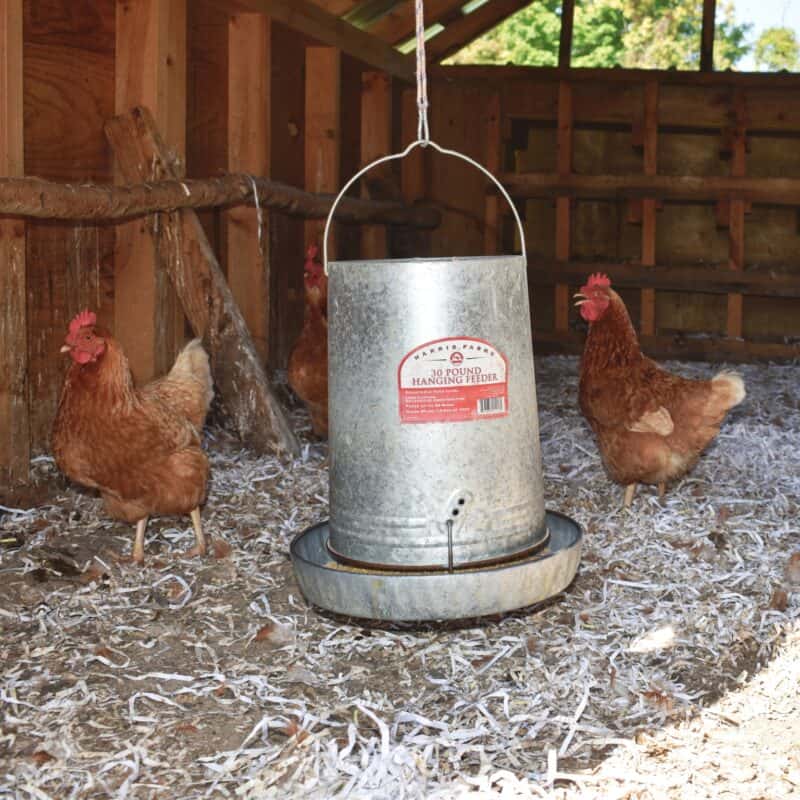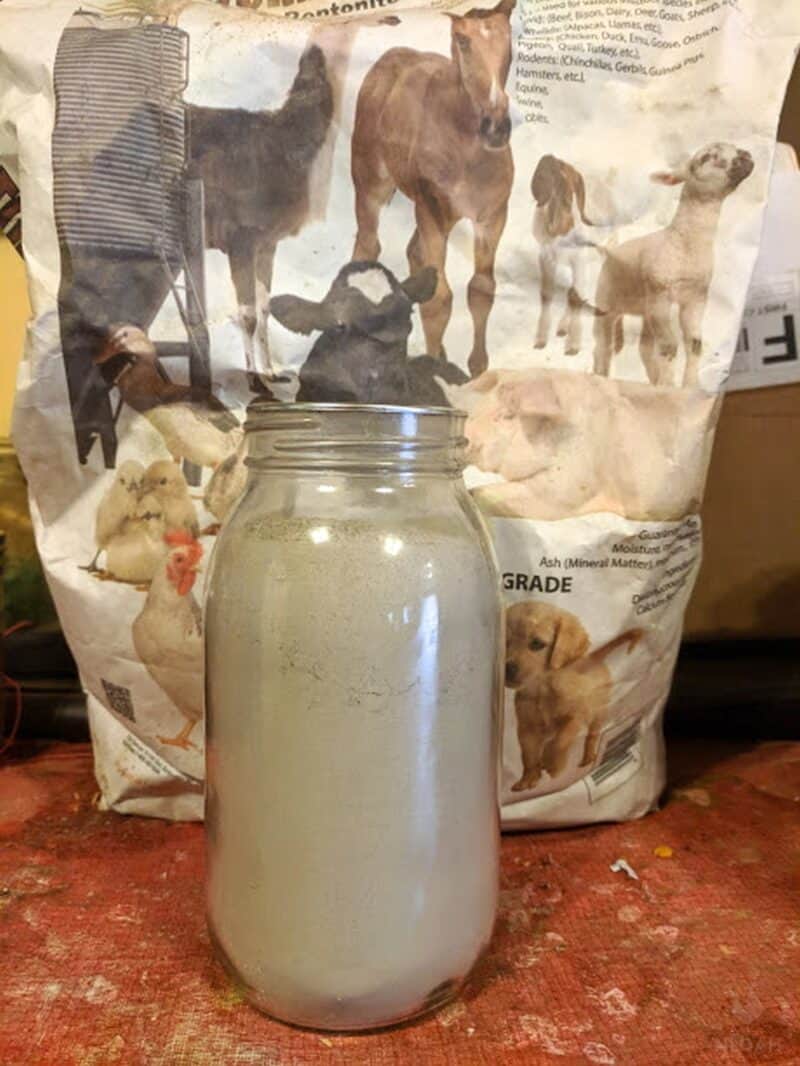If you own chickens, you’re already involved in a battle. A battle that will never, ever end. I’m talking about the battle against chicken parasites, of course, blood-sucking little monsters that can drive our poor birds crazy, hurt them, and even kill them.

They’ll keep you busy, alright, but luckily we have diatomaceous earth on our side.
Diatomaceous earth is a natural mineral that can get rid of parasites before they ever get to our flock by sprinkling it all around the interior of our chicken coop.
But, like all good defenses, it must be refreshed periodically. How often should you sprinkle this stuff around your coop?
Ideally, you should sprinkle diatomaceous earth around your coop every 2 to 3 months, and after every deep clean. This will ensure that parasites are kept at bay and cannot establish a foothold in the coop.
As long as your regular rounds of DE application are kept up, you can rest assured knowing that your birds will be dealing with a greatly reduced parasite presence.
There is a lot more to learn about diatomaceous earth and its application for pest control, and I will be telling you all about it below.

What is Diatomaceous Earth, Exactly?
Diatomaceous earth, or DE, is a naturally occurring sedimentary mineral made up of the fossilized remains of incredibly tiny organisms called diatoms. Hence, “diatomaceous” in the name.
Long used as an industrial absorbent media and filtration material due to its porous structure and large surface area, its uses as a natural, chemical-free insecticide makes it invaluable for keeping your chicken coop free of parasites.
Why Should I Sprinkle Diatomaceous Earth in the Chicken Coop?
You should use DE in and around your chicken coop because nothing else natural works as well or as long for preventing and controlling parasites. No chemicals, no-nonsense.
DE kills parasites by contact, and is fine enough to completely cover all surfaces in your coop, including the tiny little crevices and hidey holes where these bloodsuckers like to hide and breed. Adults, juveniles, and eggs, DE kills them all.
How Does Diatomaceous Earth Kill Off Pests?
DE works by cutting and drying out the parasites’ exoskeletons, causing them to die off. The stuff is so abrasive that it literally slices into the buggers.
When this occurs, the bugs will either be killed by mechanical laceration, especially if they get the stuff under their shells and skins, or from dehydration since they won’t be able to retain moisture.
It is a rough way to die, but they started the war, not us…
Is Diatomaceous Earth Toxic or Poisonous to Chickens?
Not really. DE is completely natural (so long as you buy the right kind, more on that in a sec) and is not chemically reactive or toxic.
However, it can be an inhalation hazard for chickens since the stuff is so fine. This is usually only a concern if it is hanging in the air or if you use way, way too much of it.
A little common sense in application, like keeping your chickens out of the coop while you are applying and after until the dust has settled, will keep your flock safe.
Is Diatomaceous Earth Toxic or Poisonous to People?
No, though it is an inhalation and skin irritation hazard as mentioned above, same as chickens.
You’ll want to use a mask that is rated for very fine dust particles when handling diatomaceous earth for this job and wear gloves as well.
Are There Any Other Drawbacks to Using Diatomaceous Earth?
The major drawback of DE is that it doesn’t work while it is wet. DE must remain completely dry in order to do its job, so if you live in a wet and rainy climate this option may not be the best for you.
It will also be deactivated when you rinse your coop out, or if your dear birds spill some water in there.
However, it will reactivate when dry: remember it isn’t a chemical, it is not being diluted by water.
The other significant drawback, though not one you may care about, is that DE kills bugs and other smaller critters indiscriminately.
So, if you have beneficial bugs living in and around your coop like spiders and beetles, they will also die off right along with the bad critters.
If you are into organic pest control with a least-possible-harm attitude, this may be something to consider.
Caution: Only Use Food-Grade Diatomaceous Earth for Pest Control
When buying DE, be sure to check the package and purchase the food-grade version specifically. If getting your DE from a farm or livestock supply store, just check the label or ingredients list.
Not all DE is created equal and not all of it is safe when used in this way: filter-grade diatomaceous earth, aka Pool Grade DE, can contain toxic and dangerous levels of crystalline silica that can cause really serious harm if inhaled or ingested, by people and chickens alike.
Food-Grade diatomaceous earth is safe and contains just DE alone.
How Should I Apply Diatomaceous Earth in and Around the Chicken Coop?
Applying DE is a cinch, but proper preparation makes all the difference.
Clear and Clean the Coop: Before applying DE to your chicken coop, you must first shoo out the chickens, remove the ground cover, and give the coop a deep cleaning if necessary.
Apply the DE: You have two options. You can either mix up a strong solution of DE and water, mopping it all over the coop, or sprinkle it everywhere and on every surface.
In both cases, really work it into the nooks and crannies. If using the solution, the DE will activate when dry. This method can help to control airborne dust.
Reset Ground Cover: Mix some DE in with the fresh dirt or shavings you use to cover the floor of your coop, as well as with any ground cover outside the coop.
Apply Around Perimeter: Place a thick line of remaining mixture or powder along all outside edges of the chicken coop and run areas including windowsills and doorsills (if present).
Using a paintbrush will make this process easier. This will form barrier that insects can cross, but will surely kill them in time.
Reintroduce Chickens: When all is said and done, let the chickens back in.
You’re finished. Your DE should last and remain effective for 2 to 3 months, after which time you may need to reapply.
When Should I Reapply Diatomaceous Earth?
If there are signs that parasites have started affecting your birds then the protection of the DE has likely worn off. Time to reapply!
Likewise, you should be reapplying every 2 to 3 months whether it seems like the coop needs it or not, and always do it after any deep clean or ground cover replacement.
You should always take the time to really work the DE into the cracks and crevices of the coop, as this is where many parasites will hide, breed and lay eggs.
Diatomaceous Earth Does Take Time to Work
Last thing: DE is not like chemical pesticides that kill in seconds or minutes. It takes time to work because it is slowly degrading and the puncturing the little buggers plaguing our birds. That’s the tradeoff.
If your flock is already suffering from parasite infestation on their bodies or in the coop, it is easy to feel like DE isn’t doing anything because the bugs will go right on munching.
Don’t despair: it is working and will reduce and with luck eliminate the pests but it takes time to kill off enough of the population to start interrupting the life cycle of these critters. Be patient, and know that this is how they’ll eventually meet their fate!
Diatomaceous earth is a great tool in your pest-control arsenal and an organic one, but it must be applied correctly and with an understanding of its limitations.
Tom has lived and worked on farms and homesteads from the Carolinas to Kentucky and beyond. He is passionate about helping people prepare for tough times by embracing lifestyles of self-sufficiency.
